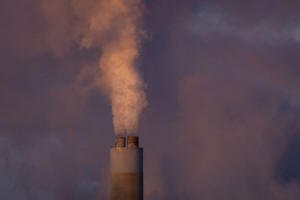Efforts to put carbon dioxide underground face less support in Trump's
second term
 Send a link to a friend
Send a link to a friend
 [February 10, 2025]
By MEAD GRUVER [February 10, 2025]
By MEAD GRUVER
CHEYENNE, Wyo. (AP) — Putting carbon dioxide from power plants and
industrial facilities underground where it won’t contribute to global
warming could see less federal support and enthusiasm under President
Donald Trump. But experts and industry advocates doubt demand for the
technology will go away as long as utilities face state-level climate
change goals.
Trump has vowed to “drill, baby, drill” for fossil fuels and ordered the
U.S. to withdraw from the landmark Paris agreement to try to limit
Earth's warming. Meanwhile, his new energy secretary, Chris Wright, has
vowed to prioritize “affordable, reliable and secure energy” in a
policy-setting order that criticizes zero-carbon goals and makes no
mention of carbon capture.
Carbon capture's doubters include both conservative policy organizations
and environmental groups . Even so, its outlook in the U.S. isn't all
bleak.
Carbon capture got a $12 billion boost under Joe Biden through increased
tax incentives and funding through the Inflation Reduction Act and
Bipartisan Infrastructure Law. With projects scattered nationwide,
including dozens in Republican states, there may be less appetite to
include them in budget cuts, said analyst Rohan Dighe with the energy
and resources research firm Wood Mackenzie.
But a broader trend away from “environmental, social and governance”
investing, or ESG, could sap momentum for carbon capture, Dighe said by
email.
“So even absent government rollback of funding, we could see fewer
project announcements and movements due to lower interest in
decarbonizing,” Dighe wrote.

Carbon capture involves separating carbon dioxide from the emissions of
power plants and other industrial facilities and pumping it underground.
The goal can be either to store it permanently so it doesn't contribute
to climate change, or to pressurize an oilfield to help increase
production.
Carbon capture has deep support in Republican Wyoming, home to projects
including an ExxonMobil plant that separates CO2 from sour gas wells for
use in aging oilfields and another experimenting with putting power
plant CO2 underground.
In 2021, GOP Gov. Mark Gordon pledged to make the sparsely populated
state — which exports 12 times more energy than it consumes — not just
carbon neutral but “carbon negative.”
Carbon capture features prominently in that plan. In 2020, Wyoming,
which contributed tens of millions of dollars for a carbon capture
research facility at an operating power plant, became one of the first
states to regulate underground carbon dioxide injection itself rather
than through the EPA. That list now also includes Louisiana, North
Dakota and West Virginia.
But there’s also growing skepticism in Wyoming, the nation's top coal
producer. With Trump back in office, some question the need for
greenhouse gas goals.
One state lawmaker recently proposed legislation titled “Make Carbon
Dioxide Great Again” that would back off carbon capture including a 2020
state law requiring utilities to study how much it would cost to install
at the state's fossil-fuel-fired power plants.
No other lawmakers supported the bill and it failed.
Meanwhile, Gordon is sticking with carbon capture to help protect
Wyoming's coal industry. Eighteen states that account for almost
two-thirds of Wyoming's coal market have renewable energy and
carbon-neutrality goals, Gordon spokesman Michael Pearlman said by
email.
[to top of second column]
|

Carbon dioxide and other pollutant billows from a stack at
PacifiCorp’s coal-fired Naughton Power Plant, near where Bill Gates
company, TerraPower plans to build an advanced, nontraditional
nuclear reactor, Jan. 13, 2022, in Kemmerer, Wyo. (AP Photo/Natalie
Behring, File)
 "To keep that market, we have to use
carbon capture," Pearlman wrote.
The billions of dollars in federal grants for
carbon capture approved under Biden have aided dozens of carbon
capture projections nationwide through the Department of Energy’s
CarbonSAFE program. Seven are in Wyoming.
The future of the “45Q” tax credit for carbon capture projects
especially worries the Carbon Capture Coalition, a group of more
than 100 environmental groups, unions and companies. It recently
urged Congress to uphold the credit, which was included in the
Inflation Reduction Act.
To date, the Petra Nova facility outside Houston, whose CO2 is used
to increase production at nearby oilfields, is the nation's only
power plant that puts the greenhouse gas underground on a commercial
scale. More could be coming eventually. Government support helped
spur 270 carbon capture projects across the U.S. in the past few
years, the coalition wrote to congressional leaders.
“We wanted to kind of put a stake in the ground,” said Madelyn
Morrison, the group’s government affairs director.
Republicans have voted dozens of times, unsuccessfully, to repeal
portions of the Inflation Reduction Act when they held a minority in
the Senate, according to the Brookings Institution. Now that they
control the Senate, House and White House, the bar to repeal is
lower.
That would have support from the conservative Heritage Foundation, a
longstanding opponent of carbon capture. Requiring carbon capture
for coal- and gas-fired power plants would be costly just when
electric vehicles are increasing energy demand, the group argued in
a paper last year.
Others on the right say building out the network of pipelines and
injection wells necessary for carbon capture threatens to trample on
private property rights.
“Carbon capture and storage projects are nothing more than an
opportunistic scheme to make vast sums of money from a problem that
arguably does not exist,” concluded a January report by the
conservative Heartland Institute that recommended abolishing the 45Q
tax credit.

Earthjustice and other environmental groups oppose carbon capture
largely because they see it as dubious cover to maintain fossil fuel
production.
For the Carbon Capture Coalition, the technology is a middle ground
recognizing that neither carbon-free energy production nor an end to
burning fossil fuels will happen overnight. Even if Trump is all in
for fossil fuels, U.S. consumers and the global market will demand
the technology, the group says.
“In order for these American industries to really remain
competitive, not only in domestic markets, but really in the global
marketplace, their businesses really depend on investing in
innovative solutions like carbon management,” Morrison said.
All contents © copyright 2025 Associated Press. All rights reserved |